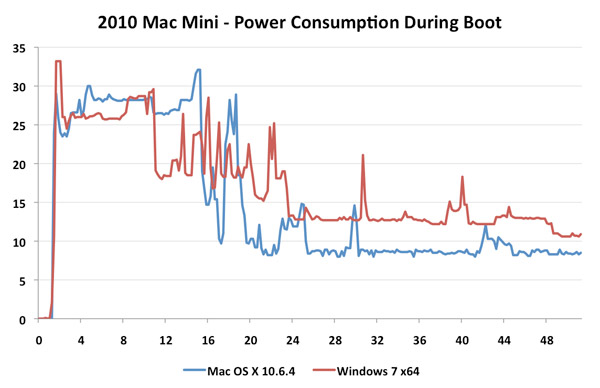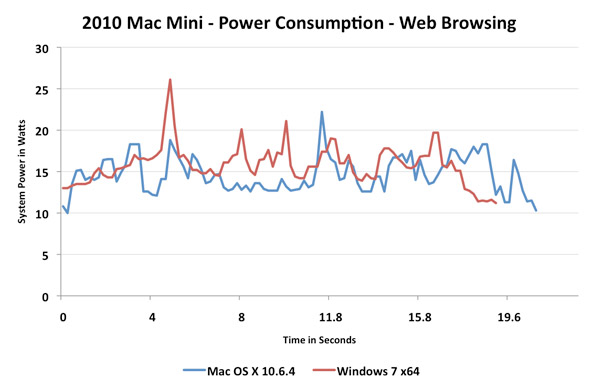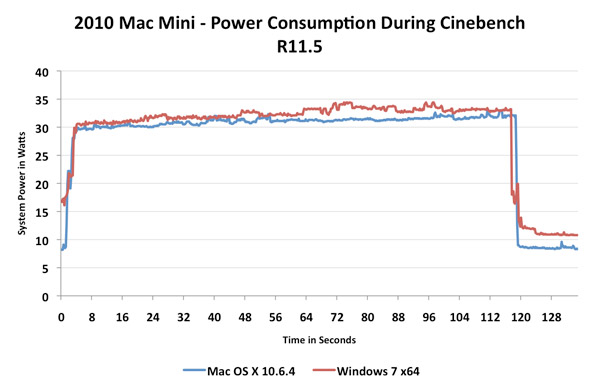Apple Mac mini Review (Mid 2010)
by Anand Lal Shimpi on August 9, 2010 3:37 AM ESTHonest Apple & Energy Efficiency
Apple calls the new Mac mini the world’s most energy-efficient desktop computer. I thought that might be a bit of a stretch but if you look at the numbers, they’re very convincing.
Zotac’s HD-ID11, an Atom based next-generation ION nettop, idles at 21.7W. Even the ASUS UL50V notebook, with a Core 2 Duo SU7300 (1.3GHz) ultra low voltage notebook CPU idles at 8.1W with the screen disabled.
Now that 8.1W number is unrealistic for a notebook. The screen was disabled, battery removed, WiFi disconnected and no ethernet cables plugged in. If I run the 2010 Mac mini in a similar configuration (minus the display/battery part since, well, they don’t exist), the entire system consumes 7.5W at idle.
Connect to a WiFi network, plug in an Ethernet cable and you’re looking at 8W. I have not seen a modern desktop machine idle at lower power than the 2010 Mac mini.
| 2010 Mac mini Power Usage | ||||||||
| Idle | Half Life 2 Episode Two | DVD Playback | Web Browsing | Quicktime Encode | Cinebench R11.5 | |||
| Apple Mac mini (Mid 2010) | 8.0W | 26.4W | 16.1W | 8.6W - 19W | 30.3W | 30.0W | ||
Part of this has to do with Apple’s very efficient integrated PSU. Unlike the other two systems I mentioned here, the mini uses a custom, integrated 85W PSU specifically designed for the system’s load.
Part of it has to do with Apple’s component selection. The mini is built entirely out of notebook parts with a custom motherboard design devoid of anything unnecessary. I’ve even heard that Apple goes to great lengths to ensure the CPUs/GPUs/chipsets it gets are on the lower power portion of the yield curve for products like the mini or MacBook Air.
The third explanation for why Apple is able to make such a bold claim about the Mac mini’s power consumption has nothing to do with hardware at all. As we’ve shown in the past, Mac OS X tends to offer better battery life than Windows in situations where the system sees a lot of idle time. Reading web pages, typing a document, etc... all tend to expose this advantage. Under load however, the OS X power advantage disappears - we are after all dealing with the same components regardless of OS.
The idle battery life advantage comes from lower idle power, presumably through heavy OS and hardware optimization. While I measured 8W at idle under OS X, running Windows 7 (power saver mode) on the Mac mini resulted in a 12W idle power without any changes to the hardware. Granted I don’t have identical hardware by another manufacturer to confirm that this isn’t negligence on Apple’s part to optimize its firmware for Windows 7. However in the past we’ve shown that systems from Lenovo, despite having similar specifications to Apple notebooks deliver worse idle battery life. I believe it’s safe to assume that part of the reason Apple is able to make such a bold claim about the mini’s energy efficiency is because it is the only desktop that can be sold running Mac OS X.
I recorded the mini’s power consumption over time running both OS X 10.6.4 and Windows 7 x64 to give you an idea of where the power consumption differences come into play.
This first chart shows power consumption during the boot process. From power on until you get a cursor at the desktop and the system’s power draw stabilizes for a while. The red line is Windows 7, the blue line is OS X:

Peak power consumption is nearly identical between the two OSes during the boot process. However, OS X drops down to idle sooner (finishes booting quicker) and remains at a lower idle point than Windows 7. Both OSes experience blips of activity after we reach the desktop as additional services are started.
The next test is some basic web browsing using Chrome. I loaded the AnandTech front page, scrolled to an article, clicked on it, scrolled down to the comments and recorded system power consumption:

I tried to get both runs as close as possible to one another, but I am human. Even while browsing the web the CPU has ample time to go into lower power states. Total platform power dips lower under OS X and is lower overall.
Our final test shows a run of Cinebench R11.5. The legend is the same, red for Windows, blue for OS X, but this time the CPU is pegged at 100% for the duration of the test:

The two systems are nearly identical in terms of power consumption. OS X still offers a slight advantage that’s consistent but not pronounced. The render completes in approximately the same amount of time in both OSes, although Windows is a hair quicker. The mini under OS X scored 1.38 points vs. 1.39 under Windows 7.
Since there is a performance difference here, it could just be that Apple is optimizing for power consumption rather than peak performance in the OS itself. It’s difficult to analyze but it’s something I am seeing fairly consistently.










93 Comments
View All Comments
MonkeyPaw - Monday, August 9, 2010 - link
I don't understand why it has to keep getting smaller and smaller. The original Mini is by no means a monster. I remember setting an old FX5900 on my old G4 mini, and I laughed that the card stuck out about 2" on each side.I guess my point is that I would have rather seen Apple boost the specs all around as opposed to shrinking the package (and raising the price). Apple continues to miss the boat (at least my boat, anyway) when it comes to price/features. I just don't think Apple cares about market share. They want to continue to sell overpriced items to a smaller audience. I guess that's fine, as they seem to make nice profits doing so. But the original Mini made me buy my first mac, and eventually I bought an iBook and a dual-G5. The dual G5 became mysteriously crash-happy, and I haven't been back since. Appke just can't draw me back in yet, not with this price/product.
thunng8 - Thursday, August 12, 2010 - link
That is not correct anymore these days. Modern 7200rpm 2.5" hard drives are only marginally hotter than the 5400rpm variety. It would make no difference in a mac mini enclosure.woutersamaey - Monday, August 9, 2010 - link
It would've been nice to read more on the Mac Mini with Mac OS X Server. To my opinion, it looks like an interesting SOHO server. It has faster (2 of them) 7200 rpm disks and 4 GB of RAM.solipsism - Monday, August 9, 2010 - link
Anand wrote, "With no DMI/QPI enabled NVIDIA chipsets, Apple is either going to have to increase the physical size of many of its products to transition to newer Intel CPUs with 3rd party GPUs or live with Intel/AMD integrated graphics going forward. I'm very curious to see how this plays out over the next 12 - 18 months.”There is plenty of space when they remove the ODD. It’s obvious they aren’t going to move to Blu-ray if they haven’t in August 2010 and haven’t even added AACS to Mac OS X.
The ODD is large, slow, prone to breaking and goes unused by most consumers these days. To put it into perspective takes up 25% of the 13” MB/MBP footprint, as well as 5” of port-side space which all Mac notebooks could use.
On top of that, there is no 9.5mm Ultra-Slim Slot-Loading BRD that would be feasible for the needs of a company obsessed with thin.
Honestly, Anand, if they haven’t added AACS to Mac OS X, added the option to their Mac Pros with full-sized ODDs, and left their optical disc authoring apps to rot why would you even expect this to arrive in such a svelte machine as the Mac Mini.
Ratman6161 - Tuesday, August 10, 2010 - link
...because that isn't what this system uses. Take a look at the page in the review where they show pictures of the system torn down and talk about the Nvidia GeForce 320M and go on to say "The 320M has the graphics, memory controller, SATA controller, PCIe and USB interfaces. " The 320M seems to be a common part on Windows based laptops so it's nothing special - but it isn't Intel.larson0699 - Wednesday, August 11, 2010 - link
@solipsism: The new mini also has a server edition ($1k, apple.com/macmini/server), 2 HDD, no ODD, though none of that open vertical space helps the limited real estate of the motherboard itself.@Ratman6161: As far as I can tell, only Apple has used the GeForce 320M thus far -- you may have mistaken that for the GeForce GT 320M, the former being an IGP and the latter a discrete GPU. Notebookcheck is a great place to compare mobile GPUs by specs, 3DMark scores, and their uses among OEMs, and that's where I learned of the similarly named IGP.
mschira - Monday, August 9, 2010 - link
How does the Mac mini fare with a contemporary medium demading game, such as Starcraft 2?Best
M.
jabber - Monday, August 9, 2010 - link
For that price and application I would want a BD drive in it.I mean a BD drive would be what? An extra $50 (real world price) bu then the Apple price would be an extra $200.
Hmmmm.
Johnmcl7 - Wednesday, August 11, 2010 - link
Not just the cost but also a threat to streaming HD content from Itunes which seems to be another reason for not having blu-ray according to Steve Jobs.I agree with you though hence I bought a Dell Studio Hybrid which is a very similar machine in that it uses laptop component but it also has a blu-ray drive - I'm surprised it didn't get a mention at all in the article.
John
PrincePickle - Monday, August 9, 2010 - link
At least Apple is concentraiting on bringing decent GPU's to their lineups. The industry as a whole has been slacking with educating consumers on the benifits of discrete GPU's.